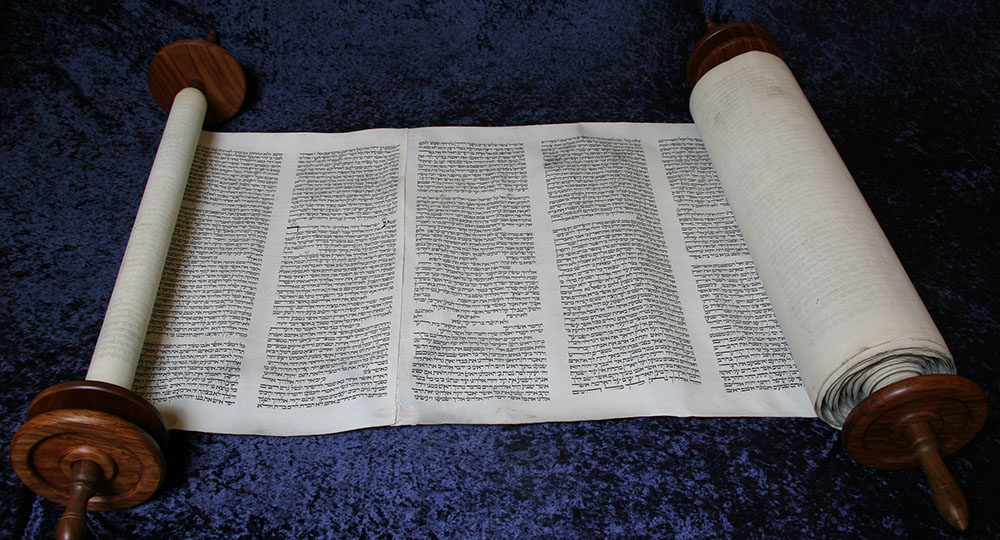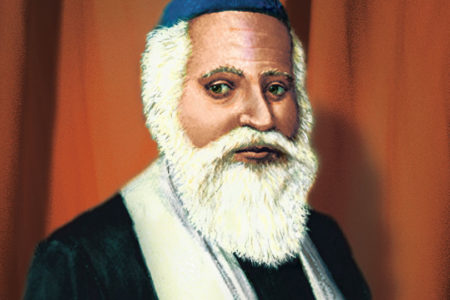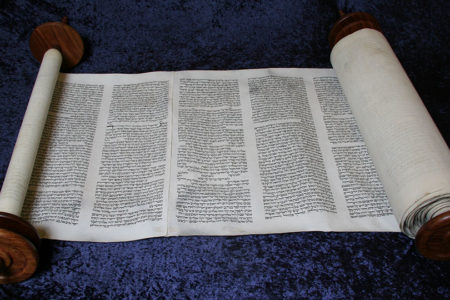Students Learn from Ancient Scrolls From the Days of the Vilna Gaon
Why preserve ancient words? I can hear the response of one of my Jewish professors from college days as clearly as if I were sitting in his classroom today: “Such a question!”
In those days it was assumed that college professors were repositories of the accumulated knowledge of the generations and that students were empty heads waiting to be filled. But that was two generations ago, and times have changed. Today students are more likely to ask questions like, “What is the relevance of this activity for me and for my career?” Or, “Shouldn’t we be more interested in changing the world we were given rather than preserving it?”
Fortunately for teachers of Hebrew, such as me, students who choose to attend a Bible college come because of their devotion to ancient words: the preserved words of the Holy Scriptures. These students understand that the words of the Bible are living, powerful, and able to change lives (Heb. 4:12). Our challenge is to make English-speaking students, who have always used English translations of the Bible, realize the value of working with the Hebrew words of the Old Testament. We must expose students to this heritage and to their debt to the generations of scholars who gave their lives to preserve these words for them.
The opportunity to take up this challenge in a unique way providentially presented itself when Baptist Bible College (BBC) in Clarks Summit, Pennsylvania, where I teach, was loaned a rare 18th-century Torah scroll. Experts at the Machon Ot, a scribal institution in Israel for repairing Torah scrolls, had declared this particular scroll pasul, that is, invalid for sacred use. An American foundation then acquired the scroll, believed to have come from Vilna, Lithuania, to make it available to institutions where the Hebrew Scriptures are honored as God’s Word and the Jewish people are loved and respected.
Although repaired many times in its three centuries of use in a synagogue, it could no longer be restored to the strict requirements of STaM. STaM is an acronym for Sifrei Torah (the handwritten Torah scrolls used in synagogues), Teffilin (the handwritten Bible verses encased in phylacteries), and Mezuzot (the handwritten Bible verses encased in small containers displayed on the doorposts of Jewish homes and buildings).
The rabbinic rules for STaM require that each letter of each word clearly display its distinct form. In many portions of this scroll, the leather’s surface was too worn or damaged to see the letters distinctly, so the scroll was judged unfit for synagogue use. Ironically, it was the inability of the scribes, called sopherim, to continue to preserve this scroll for sacred use that made it possible for others to preserve it as a document of Jewish heritage for future generations.
When Gary Zimmerman, a representative of the foundation that loaned us the scroll, came to campus, he excited the students’ imaginations with lectures about scribal techniques and the meticulous way the scribes wrote and preserved Torah scrolls.
When you unroll a 300-year-old Torah scroll, show Christian students the beautiful and painstaking detail of the manuscript, and ask whether they would like to be part of a project to preserve the scroll for future generations, they, too, respond, “Such a question!”
The eventual goal of the Torah Scroll Project is to Internet publish photographs and a detailed report of the 18th-century Torah scroll for the benefit and blessing of anyone who accesses the site. The Internet has made it possible for documents and artifacts to be preserved in a format far more accessible than storage or display in a museum. Future generations of scholars will be able to work with facsimiles of the scroll and with the data gathered by the project.
The Torah Scroll Project is a vast undertaking, but the benefits are enormous. The project is a means to teach our students about the heritage of the Jewish scribes, improve their knowledge of the Hebrew Bible, and engage them in preserving this unique manuscript. Our college had a pool of students eager to work with the Torah scroll. BBC offers three years of Old Testament languages, including Hebrew, Aramaic, Ugaritic, and Hieroglyphic Egyptian. Each semester we have anywhere from 60 to 100 students enrolled in these courses. We decided to allow second- and third-year Hebrew students to work on the project.
Unlike the Hebrew Bibles that college and seminary students use, Torah scrolls contain no vowels, chapter or verse markers, or even the name of the book at the top of the page. Working with unvoweled text requires a higher degree of fluency in Hebrew. Our second- and third-year Hebrew students showed a marked increase in their proficiency in biblical Hebrew because of the project. Also, Torah scrolls do not use the letter styles found in printed Hebrew books. The rules of STaM require they be handwritten in a special writing style so that each letter is distinct and cannot possibly be mistaken for another. This STaM font marks many letters with three tiny slashes, called taggin (literally, “crowns”) because they “crown,” or adorn, certain letters.
Our scroll was especially challenging because it was the product of a kabbalistic Jewish community. Kabbalistic Jews believe there is a mystical power in each individual letter. Kabbalistic scrolls use unique letterforms and flourishes to convey a deeper meaning to certain letters in specific words. Our students had to become completely conversant with the complex rules of STaM in order to recognize the differences in the kabbalistic letterforms.
When Bible students learn that the sopherim actually counted the words and letters of each book, they marvel at such dedication. After our students learned how to check the work of the sopherim, they understood the necessity for such rigid, pedantic procedures.
Each student was assigned two or three pages of the Torah scroll. To recognize and record each unique feature of the kabbalistic letterforms, every student had to prepare his or her own copy of the assigned pages in the standard STaM format for comparison with the scroll. To do so, the students had to learn to work with a Hebrew word processor and to edit and print their sections of the Hebrew text in the exact order, column, and line of the manuscript.
In a curious way, the students had to enter the world of the ancient scribe and do the work of a sopher. This was no easy task. Today’s students are accustomed to reading rapidly and using lightning-fast, computerized instant-messaging. They come to college with software that checks their spelling and corrects (some of) their grammar. Students reported that the most difficult skill to acquire was learning to slow down and do careful, meticulous work.
After they had prepared a computer-generated copy of their assigned pages, they were ready to learn how to work with the 300-year-old Vilna scroll. The manuscript is made up of 53 leather pages of uneven size, sewn together into one scroll. Handling it with bare hands not only violates the convictions of many Jews, but it also endangers the preservation of the prepared leather itself; the smallest amounts of sweat from hands or fingers will eventually darken the scroll and make it illegible. So we all had to wear gloves.
The students had to examine every letter of the text, using a magnifying glass when necessary. Every unique or embellished letterform, every departure from STaM, had to be noted and identified. Every letter was compared with the STaM requirements. The minutest details were checked. For example, we found that many letters that were supposed to be marked with three taggin slashes were written with two instead; some letters were missing the required taggin completely; and some were marked with taggin that were not supposed to be there.
Every letter worthy of note was circled in the corresponding word on the computer-generated copy. Each form was circled and assigned a letter (a for the first instance in a line, b for the second, etc.). Then a description of the form was written in the margin of the computerized copy.
Marginal notes also recorded where sopherim had erased the original letters in order to repair and restore the proper ones. Notations were made for blotches or water damage. Above all, the students had to record their work neatly and consistently. Writing neatly may be the second most difficult skill these students acquired!
The results will be entered into a computer database and added to the published pictures of the scroll on the BBC Web site. This semester we will recruit a new crop of students to design, publish, and maintain the Web site.
Tedious work? The students in the Old Testament Project Center didn’t think so. By the time they opened the scroll for themselves, they were able to look at it from a new perspective—that of the ancient scribe who had written it and the sopherim who had preserved it. The sopherim had labored so diligently to preserve this scroll for the use of a single Jewish community. Someday, Lord willing, our work will preserve their work, online, for the entire world.








This is a wonderful Torah Scroll. It is being used at Congregation Beth Messiah in Houston, Texas. I purchased this Scroll from Machon OT in Jerusalem in 2004. Each column of the entire Scroll has been photographed in high resolution and can be studied on my website at:
https://gracetranscendingthetorah.com/tanakh-wip/